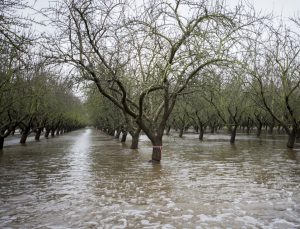From a California Water Commission News Release
The California Water Commission has approved a white paper that contains potential strategies to protect communities and fish and wildlife in the event of drought.
The white paper is in support of Water Resilience Portfolio Action 26.3, and will be shared with the Secretaries for Natural Resources, Environmental Protection, and Food and Agriculture, who requested the Commission’s engagement on this topic.
California is a drought-prone state. Climate change exacerbates drought conditions in California by creating hotter and drier baseline conditions, leading to more intense droughts. Additionally, climate change is creating the conditions for “weather whiplash” – a phenomenon California experienced in the 2022-2023 water year, swinging rapidly from severe drought to record-breaking precipitation events and flooding.
To ensure California’s people and environment have sufficient water during times of drought, the State will need to adapt to this new normal of ongoing weather extremes.
“California has experienced two of the worst droughts in our state’s history in the last decade alone,” said Natural Resources Secretary Wade Crowfoot. “While we’ve invested billions across the state to become more drought resilient in light of this new reality, there’s more we need to do to prepare for the next drought, whenever it comes. These thoughtful recommendations by the Water Commission point the way forward and I’m eager to explore how these ideas can be applied in coming years.”
The Commission’s work on drought is forward-looking. The strategies proposed by the Commission integrate months of conversations with State agencies, experts, Tribes, water users, interest groups, interested parties, and the public. The Commission has taken the input it received and charted a through-line, developing four key strategies for augmenting California’s communities’ and fish and wildlife species’ drought resilience.
1. Scale up groundwater recharge. During flood events, when all other water rights and environmental needs are met, channeling excess flows to groundwater recharge can build drought reserves. The State can help scale up groundwater recharge by planning and preparing for recharge during times of high flow, promoting recharge efforts through outreach and financial incentives, efficiently permitting recharge projects, supporting the infrastructure needed to conduct recharge, and continuing to apply lessons learned.
2. Conduct watershed-level planning to reduce drought impacts to ecosystems. To enable fish and wildlife to be more resilient to drought, the State must support fish and wildlife during drought and work to recover ecosystem function during non-drought periods, supporting viable populations that can weather the next drought period. The State can help reduce drought impacts to fish and wildlife by improving water availability for species, advancing habitat restoration and conservation projects, integrating forest management into drought planning, and creating a plan to protect species during drought emergencies.
3. Better position communities to prepare for and respond to drought emergencies. During drought, communities need resources to ensure that vulnerable community members are safe in times of crisis. In advance of drought, they need support to help abate future vulnerabilities to water scarcity by improving water systems and integrating water use into land use planning. The State can help communities prepare for and respond to drought by offering climate disaster funding, ramping up efforts to improve water system resilience and regional water solutions, and supporting integrated land and water planning.
4. Support improved coordination, information, and communication in drought and non-drought years. In California, droughts need to be dealt with as a chronic phenomenon and not an occasional emergency. The State needs to continue to align its staff capacity, improve its data collection, and contextualize its drought communication, moving from a crisis mindset to recognizing drought as a natural and inevitable element of the state’s hydrologic cycle.
“Groundwater recharge to replenish our aquifers is a key water strategy for a hotter, drier future,” said California Department of Food and Agriculture Secretary Karen Ross. “It provides important ecosystem benefits, protects drinking water wells, and supports climate-resilient agriculture for healthy food production and thriving rural communities.”
The strategies and actions outlined in this paper are additive to the important work already underway by State agencies. The Commission expects State decision-makers to weigh whether and when to move forward with these suggested strategies.
“Drought impacts all of California’s water users, but some – small, rural communities and fish and wildlife – are particularly vulnerable,” said Commissioner Sandra Matsumoto. “The strategies proposed by the Commission will help the State protect these vulnerable water users in the event of drought. To move forward, water sectors, users, and managers must work together to minimize the impacts of drought on all Californians.”



